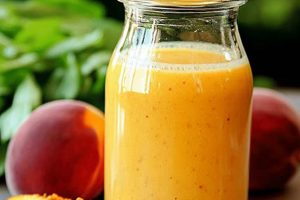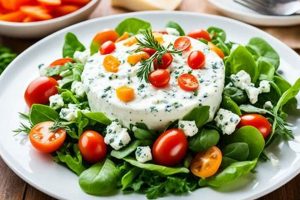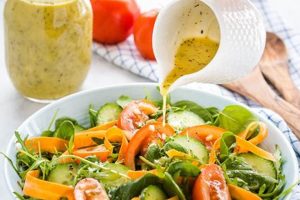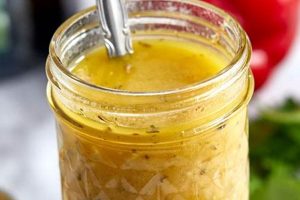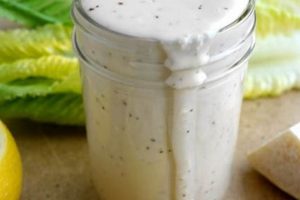Fundamental salad dressings based on olive oil offer a healthy and flavorful foundation for a wide array of salads. These typically involve emulsifying the oil with an acidic component like vinegar or citrus juice, often enhanced by seasonings such as herbs, spices, salt, and pepper. A classic example combines extra virgin olive oil, lemon juice, minced garlic, salt, and freshly ground black pepper.
Such dressings contribute significantly to both the nutritional value and palatability of salads. Olive oil provides monounsaturated fats and antioxidants, while acidic elements offer vitamins and brightness. The simplicity of these recipes allows the fresh flavors of the ingredients to shine. Historically, olive oil and vinegar have been staples of Mediterranean cuisine, prized for their health benefits and culinary versatility. This foundation continues to inspire contemporary culinary creations.
The following sections will explore various combinations of ingredients and techniques for creating these healthful and delicious dressings, ranging from basic blends to more complex flavor profiles.
Tips for Crafting Excellent Olive Oil-Based Salad Dressings
Creating a delicious and healthy salad dressing with olive oil as the base requires attention to a few key details. These tips offer guidance for achieving optimal flavor and texture.
Tip 1: Use High-Quality Olive Oil: The flavor of the olive oil is paramount. Extra virgin olive oil, with its robust flavor and aroma, is generally preferred. Opt for a fresh, high-quality oil for the best results.
Tip 2: Balance Acidity: Acidity is crucial for balancing the richness of the oil. Common acidic ingredients include lemon juice, vinegar (red wine, white wine, balsamic), or even citrus segments. Taste and adjust as needed, seeking a harmonious balance.
Tip 3: Freshly Ground Spices: Freshly ground pepper elevates the flavor profile significantly. Consider adding a pinch of sea salt or other spices like garlic powder or onion powder to complement the other ingredients.
Tip 4: Emulsification for Texture: Whisking the oil and acidic ingredients together creates an emulsion, resulting in a thicker, more cohesive dressing that clings better to salad greens. A small whisk or even a fork can achieve this.
Tip 5: Experiment with Herbs and Aromatics: Fresh or dried herbs can significantly enhance the flavor complexity. Consider adding chopped fresh parsley, dill, oregano, thyme, or rosemary. Minced garlic or shallots also offer pungent notes.
Tip 6: Taste and Adjust: Palates vary, so tasting and adjusting the dressing to one’s preference is essential. Add more acid for brightness, oil for richness, or herbs and spices for depth.
Tip 7: Proper Storage: Store leftover dressing in an airtight container in the refrigerator. Allow it to come to room temperature before serving to allow the flavors to meld and the oil to return to its liquid state.
By following these tips, one can consistently create flavorful, healthy, and versatile olive oil-based dressings that enhance any salad.
These simple yet effective techniques provide a solid foundation for culinary exploration and enjoyment. Experimentation with different flavor combinations allows for the creation of personalized dressings perfectly suited to individual tastes.
1. High-quality Olive Oil
The foundation of a truly exceptional simple olive oil salad dressing rests upon the quality of the olive oil itself. Selecting a high-quality oil is not merely a preference but a crucial step that significantly impacts the final flavor and nutritional value of the dressing. Understanding the characteristics of high-quality olive oil empowers informed decision-making and elevates the culinary experience.
- Extra Virgin Classification:
Authentic extra virgin olive oil represents the highest quality grade, obtained solely through mechanical means without the use of heat or chemicals. This preserves the natural antioxidants and delicate flavors of the olives. Its presence in a simple dressing ensures a vibrant, fresh taste, reflective of the olives’ origin.
- Acidity Level:
A key indicator of quality is the oil’s acidity level, expressed as a percentage of oleic acid. High-quality extra virgin olive oil generally boasts an acidity level of 0.8% or lower. Lower acidity translates to a smoother, less bitter flavor, enhancing the overall balance of the dressing.
- Flavor Profile:
Olive oil exhibits a diverse range of flavor profiles depending on the olive varietal, terroir, and harvesting methods. Notes can range from fruity and grassy to peppery and robust. Choosing an oil with a flavor profile that complements the other dressing ingredients is essential. For example, a delicate olive oil might be preferred for a light vinaigrette, while a more robust oil could stand up to stronger flavors.
- Storage and Freshness:
Olive oil is susceptible to oxidation, which can degrade its quality and flavor over time. Proper storage in a cool, dark place, away from heat and light, is essential for preserving its freshness. Opting for smaller bottles ensures that the oil is used within a reasonable timeframe, maximizing its flavor contribution to the dressing.
By understanding these key factors, one can confidently select a high-quality olive oil that elevates a simple salad dressing from ordinary to extraordinary. The nuanced flavors and superior quality of the oil become the cornerstone of the dressing, enhancing the overall sensory experience and providing a healthy and delicious addition to any salad.
2. Balanced Acidity
Balanced acidity plays a pivotal role in simple olive oil salad dressing recipes, contributing significantly to the overall flavor profile and palatability. The inherent richness of olive oil necessitates a counterpoint; acidity provides this balance, preventing the dressing from becoming overly heavy or cloying. This interplay between richness and brightness elevates the sensory experience, creating a harmonious and refreshing taste.
The chemical interaction between olive oil and an acidic component, such as vinegar or citrus juice, also contributes to the emulsion’s stability. The acidity helps to bind the oil and aqueous phases together, preventing separation and creating a cohesive texture. This emulsification process is crucial for a visually appealing and evenly distributed dressing that clings well to salad greens. For example, a classic vinaigrette relies on the emulsification of olive oil and vinegar, often enhanced with Dijon mustard for added stability.
Beyond flavor and texture, acidity offers practical benefits regarding food safety. The acidic environment can inhibit the growth of certain bacteria, extending the shelf life of the dressing. While refrigeration remains essential, the acidic component adds an extra layer of preservation, particularly beneficial for homemade dressings without added preservatives. Understanding the multifaceted role of balanced acidity allows for the creation of not only delicious but also safer and more stable olive oil-based dressings.
3. Fresh seasonings
Fresh seasonings constitute a critical element in simple olive oil salad dressing recipes, significantly influencing the final flavor profile and overall culinary experience. Unlike dried herbs and spices, fresh seasonings possess a vibrant and nuanced character that elevates the dressing beyond basic oil and acid combinations. Their inclusion introduces a layer of complexity, transforming a simple dressing into a dynamic and flavorful complement to fresh salad ingredients. This impact stems from the higher concentration of volatile aromatic compounds found in fresh herbs and spices, which dissipate over time in dried forms. For instance, freshly chopped basil offers a bright, peppery, and slightly anise-like flavor to a vinaigrette, contrasting noticeably with the more subdued, hay-like notes of dried basil.
The choice of fresh seasonings directly impacts the overall character of the dressing. Herbs like parsley, chives, dill, mint, and cilantro each contribute unique flavor profiles, ranging from grassy and herbaceous to citrusy and bright. Similarly, incorporating fresh garlic, ginger, or chili peppers introduces varying levels of pungency and heat. The interplay between these diverse flavors creates a symphony of taste, transforming a simple salad into a multi-sensory experience. Consider a lemon-herb vinaigrette with fresh dill and minced garlic; the bright citrus notes of the lemon harmonize with the grassy dill and pungent garlic, creating a complex yet refreshing dressing that complements delicate greens or grilled fish. Conversely, a robust balsamic vinaigrette might benefit from the earthy notes of fresh rosemary and thyme, pairing well with heartier salads featuring roasted vegetables or grilled meats.
Maximizing the impact of fresh seasonings requires careful consideration of preparation and timing. Chopping or bruising fresh herbs releases their aromatic oils, intensifying their flavor contribution to the dressing. Adding delicate herbs like parsley or chives towards the end of the preparation prevents them from wilting and losing their vibrancy. Heartier herbs like rosemary or thyme can withstand longer exposure to the acidic components of the dressing. Understanding these nuances empowers culinary control, ensuring that the fresh seasonings contribute optimally to the final flavor profile. Ultimately, the judicious use of fresh seasonings distinguishes an ordinary olive oil-based dressing from an extraordinary culinary creation.
4. Proper Emulsification
Proper emulsification represents a critical stage in crafting successful simple olive oil salad dressings. Emulsification, the process of combining two immiscible liquidsin this case, oil and an aqueous acidic componentinto a stable mixture, dictates both the texture and the sensory experience of the dressing. A properly emulsified dressing exhibits a smooth, creamy consistency, evenly distributing flavor across the salad ingredients. This contrasts sharply with a separated dressing, where the oil and acidic components remain distinct, leading to an uneven and less palatable experience. The stability of the emulsion ensures that the dressing does not separate quickly, maintaining its desirable texture throughout the meal. A classic vinaigrette, for example, relies on emulsification to combine olive oil and vinegar, creating a cohesive dressing that clings to lettuce leaves rather than pooling at the bottom of the salad bowl.
Several factors influence the success of emulsification in simple olive oil dressings. The ratio of oil to acid plays a significant role; a typical vinaigrette often employs a ratio of three parts oil to one part vinegar. Vigorous whisking or blending provides the mechanical energy needed to disperse the droplets of one liquid into the other, creating the emulsion. Incorporating emulsifying agents, such as Dijon mustard or honey, further enhances stability. These agents contain compounds that act as bridges between the oil and water molecules, helping to maintain a uniform mixture. Temperature also affects emulsification; warmer ingredients tend to emulsify more readily and maintain stability more effectively. Practical application of this knowledge might involve gently warming the olive oil and vinegar before whisking to promote a more stable emulsion.
Achieving proper emulsification yields several benefits beyond improved texture and flavor distribution. A stable emulsion enhances the visual appeal of the dressing, presenting a cohesive and appetizing appearance. The increased surface area created by the dispersed oil droplets intensifies the release of aromatic compounds, contributing to a more pronounced flavor experience. Furthermore, a well-emulsified dressing adheres more effectively to salad ingredients, ensuring that every bite is coated with the desired flavor. Challenges in emulsification, such as separation or a thin, watery consistency, often indicate an imbalance in ingredient ratios or insufficient mechanical action. Addressing these challenges through careful measurement and thorough mixing ensures a consistently successful and satisfying culinary outcome.
5. Complementary Herbs
Complementary herbs play a crucial role in elevating simple olive oil salad dressing recipes from basic to sophisticated. The careful selection and incorporation of herbs introduce layers of flavor complexity, enhancing the inherent characteristics of the olive oil and acidic components. This synergy between herbs and other dressing ingredients creates a balanced and nuanced flavor profile that complements the salad’s other components. The choice of herbs significantly influences the dressing’s overall character. For instance, the peppery bite of fresh oregano pairs well with Mediterranean-style salads, while the bright, citrusy notes of basil complement tomato-based salads. The herbaceousness of dill enhances dressings served with fish or vegetables, while the robust earthiness of rosemary complements heartier salads featuring roasted vegetables or grilled meats. Understanding these flavor pairings allows for the creation of dressings tailored to specific salad ingredients, enhancing the overall culinary experience.
The practical application of this knowledge requires an understanding of both individual herb characteristics and the overall balance of the dressing. Delicate herbs like parsley, chives, and chervil are best added towards the end of preparation to preserve their fresh flavors and prevent wilting. More robust herbs such as rosemary, thyme, and oregano can be added earlier, allowing their flavors to infuse the dressing more thoroughly. Bruising or chopping herbs before adding them to the dressing releases their essential oils, intensifying their aromatic contribution. Consider a simple lemon-herb vinaigrette: the addition of fresh thyme introduces an earthy counterpoint to the bright citrus, creating a balanced and complex flavor profile that would complement a salad featuring grilled chicken or roasted vegetables. Conversely, a balsamic vinaigrette benefits from the addition of rosemary, whose piney notes harmonize with the sweetness and acidity of the balsamic vinegar, creating a robust dressing suitable for heartier salads.
Mastery of herb incorporation in simple olive oil salad dressings elevates culinary creativity and control. The judicious selection and application of complementary herbs transform a basic dressing into a nuanced and flavorful element that enhances the overall dining experience. Careful consideration of herb characteristics, flavor pairings, and preparation techniques allows for the creation of dressings tailored to individual preferences and specific salad compositions. Addressing potential challenges, such as overpowering herb flavors or wilting, requires attention to freshness, quantity, and timing. Ultimately, understanding the interplay between herbs and other dressing components empowers the creation of exceptional and personalized culinary experiences.
6. Flavor Adjustments
Flavor adjustments represent a crucial final stage in crafting exceptional simple olive oil salad dressings. While a foundational recipe provides a starting point, individual palates and specific salad pairings often necessitate nuanced adjustments to achieve optimal flavor harmony. This iterative process, involving careful tasting and modification, distinguishes a merely adequate dressing from a truly outstanding one. The dynamic interplay of ingredients within a simple olive oil dressingthe richness of the oil, the brightness of the acid, the pungency of herbs and spicescreates a complex flavor profile that can be fine-tuned through deliberate adjustments. For instance, a vinaigrette that tastes overly acidic might benefit from a touch of honey or maple syrup to balance the sharpness. Conversely, a dressing lacking vibrancy could be enhanced with a squeeze of fresh lemon juice or a pinch of sea salt. The specific adjustments depend on the interplay of existing flavors and the desired outcome.
Understanding the impact of individual ingredients enables effective flavor adjustments. Salt enhances sweetness and mitigates bitterness, while a touch of sugar can temper excessive acidity. Acidity, in turn, balances richness and adds brightness. The pungency of garlic or shallots can be adjusted by varying the amount used or by incorporating roasted versions for a mellower flavor. Fresh herbs introduce layers of complexity, but their intensity can be modulated through careful portioning and selection. Consider a scenario where a balsamic vinaigrette tastes overly sweet; a judicious addition of red wine vinegar would heighten the acidity, balancing the sweetness and creating a more complex flavor profile. Alternatively, if a lemon-herb vinaigrette lacks depth, a pinch of red pepper flakes could introduce a subtle heat that complements the other flavors without overpowering them.
Effective flavor adjustments hinge on iterative tasting and incremental changes. Adding small amounts of an ingredient, tasting, and then readjusting as needed prevents overcorrection and allows for nuanced flavor development. This methodical approach ensures that the final dressing achieves the desired balance and complexity. Challenges in flavor adjustment often arise from an imprecise understanding of individual ingredient contributions or a lack of patience in the adjustment process. Over-reliance on a prescribed recipe without considering individual taste preferences or the specific salad components can also lead to a less than optimal outcome. Mastering flavor adjustments empowers culinary control, enabling the creation of dressings perfectly tailored to individual palates and specific culinary contexts. This final stage of preparation, while seemingly simple, distinguishes a competent cook from a truly skilled culinary artisan.
Frequently Asked Questions
This section addresses common inquiries regarding the creation and utilization of simple olive oil-based salad dressings.
Question 1: What is the ideal ratio of olive oil to acid in a basic vinaigrette?
A standard starting point is a 3:1 ratio of oil to acid. However, the ideal balance depends on the specific acid used and individual taste preferences. Adjustments can be made incrementally to achieve the desired flavor profile.
Question 2: Can other oils be substituted for olive oil in these recipes?
While other oils like avocado or grapeseed oil can be used, they possess distinct flavor profiles that will alter the final taste of the dressing. Olive oil, particularly extra virgin, offers specific health benefits and a characteristic flavor that may not be easily replicated.
Question 3: How can one prevent homemade olive oil dressings from separating?
Thorough emulsification through vigorous whisking or blending is key. Adding an emulsifying agent such as Dijon mustard or honey further enhances stability and helps maintain a cohesive texture.
Question 4: What is the best way to store homemade olive oil salad dressings?
Store dressings in airtight containers in the refrigerator. Allowing the dressing to come to room temperature before serving enhances flavor and restores the olive oil to its liquid state.
Question 5: How long do homemade olive oil dressings typically last in the refrigerator?
Properly stored, homemade dressings can last up to one week in the refrigerator. However, the presence of fresh ingredients like herbs or garlic may shorten this timeframe. It’s best to assess the quality of the dressing before each use.
Question 6: Can simple olive oil dressings be used for purposes beyond salads?
Absolutely. These versatile dressings can be used as marinades for meat or vegetables, drizzled over roasted or grilled dishes, or incorporated into dips and sauces. Their simple yet flavorful nature lends itself to a wide range of culinary applications.
Understanding these fundamental aspects empowers culinary exploration and ensures the successful creation and utilization of flavorful and healthy olive oil-based salad dressings.
The subsequent section will delve into specific recipe examples, providing practical applications of the principles discussed thus far.
Simple Olive Oil Salad Dressing Recipes
Exploration of simple olive oil salad dressing recipes reveals their significant culinary versatility. Emphasis on high-quality olive oil, balanced acidity, fresh seasonings, proper emulsification, complementary herbs, and flavor adjustments underscores the potential for crafting exceptional dressings. These fundamental components contribute not only to flavor complexity but also to textural appeal and nutritional value. Understanding these elements empowers informed choices, transforming basic ingredients into personalized culinary creations.
Simple olive oil salad dressing recipes offer a pathway to healthful and flavorful dining experiences. Mastery of these fundamental techniques provides a foundation for culinary exploration and innovation, encouraging experimentation with diverse flavor profiles and ingredient combinations. The potential to elevate simple salads into memorable culinary experiences underscores the enduring significance of these versatile recipes.

